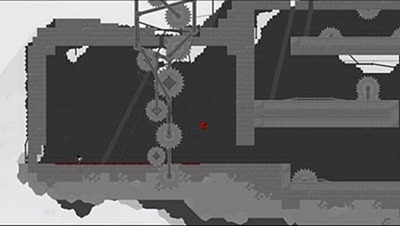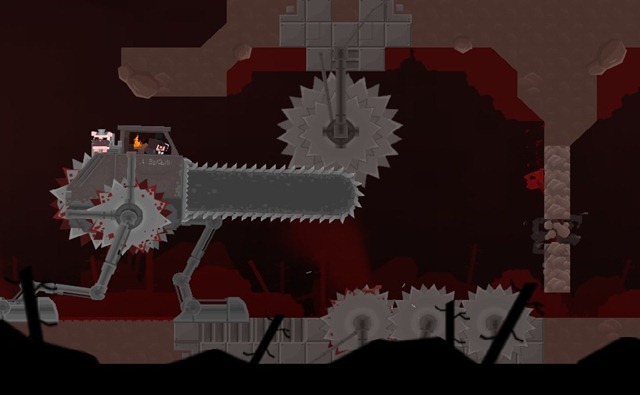We’re looking at D&D through the lens of Indie hit Super Meat Boy, and what lessons we can take from the blood-splattered and pixelated screen to our game tables. So far we’ve had part one, so that can only mean one thing: it’s time for part two!
Traps are death
Traps generally fall into one of five categories: they are designed to hold you, trigger an alarm, hurt you, slow you down, or kill you. In the Real Word (TM), most traps are the former; they are designed either to catch food or hold predators until some kindly woodsman turns up and blows their brains out. In contrast, almost all traps in D&D are designed to look like they would kill you, but unless your characters are all Minions (which would be the toughest adventure ever made) all they do is leave a scratch.
Traps in Super Meat Boy are not like that. Every single one of them is designed to kill you dead, every time.
Putting an honest-to-goodness deathtrap in D&D is generally frowned upon, especially at higher levels where the players have invested an awful lot of time into their characters over countless adventure sessions. Even so, there is a way to put them in: make the trap bloomin’ obvious. I don’t mean “make an easy Perception check” obvious neither; the deathtrap should be “there are two spinning saw-blades buzzing across the middle of the blood-caked floor, no Perception check required” obvious. Make it clear to the players that unless they somehow avoid, disable or bypass this trap (Skill Challenge, baby!), it’s Certain Messy Death Time. Write “THIS WILL KILL YOU!” on a piece of paper and stick it in the centre of the table, and keep pointing at it.
If they ignore the warning, they only have themselves to blame.
No Perception Check required.
D&D needs more chainsaws
Talking of traps, D&D has at least three races which could conceivably create chainsaws, Buzzsaws of Death and other such Steampunkish Killing Contraptions: Dwarves, Gnomes and Kobolds. Of the three, Kobolds are most likely to use such items explicitly as traps. Dwarves would use them as super-efficient tree-clearing machines (take that, elves!) and Gnomes would invent them then just leave them laying around for anyone to find. Silly Gnomes.
This is what happens when Gnomes leave things laying around for just anyone to find.
D&D With Chainsaws, as well as being an awesome name for an indie band, is one of those ideas that makes geeks squee with glee. Picture a brave Fighter cleaving Zombies and Skeletons with his Great Chainsaw +1.
You’re squeeing right now, aren’t you?
Uhu. Thought so.
Any Blade weapon can be chainsawified (which isn’t a word, but should be) by adding the Brutal 2 property (reroll a 2 or less on the damage roll) and making darned certain that every monster within Encounter distance hears the chainsaw fire up and come running to see what the commotion is. Chainsaw Weapons are powered by Lantern Oil, and can be used with any Power that requires use of the equivalent Light or Heavy Blade.
Using a Chainsaw effectively (gaining the Proficiency bonus, in other words) requires the Chainsaw Weapon Proficiency Feat. Give it for free to Fighters and Warforged if Chainsaws are particularly common and you’re feeling generous. Either set a price for the weapons according to your campaign setting, or have them discovered as part of a treasure horde.
| Weapon | Prof. | Damage | Group |
| Shortsaw | +3 | 1d6, Brutal 2, Off-Hand | Chainsaw (Light) |
| Chainsaw | +3 | 1d8, Brutal 2, Versatile | Chainsaw (Heavy) |
| Great Chainsaw | +3 | 1d10, Brutal 2 | Chainsaw (Heavy) |
| Bastard Chainsaw | +3 | 1d10, Brutal 2, Versatile | Chainsaw (Heavy) |
Chainsaws run out of Oil or Jam on an unmodified Attack Roll of 1 (50% chance of either). Refilling the Oil takes a full round, while a Jam requires a Short Rest to fix. Hope you carried a backup weapon.
I could go on, but let’s stop there. We have only really touched on the themes found inside Chapter One of this wonderful game – I don’t want to spoil any surprises, after all. I suggest you give Super Meat Boy a try for yourself. You never know – you might just like it.
Till next time!







The chainsaw seems to unwieldy of a weapon to have a +3 proficiency bonus. I think +2 would better fit it. (Honestly, I think even +2 is too high.)
I love the idea of explicit traps. For one thing, there’s no player confusion about what they should be doing. (And then griping when they get killed because they didn’t figure it out.)
I thought about dropping the proficiency bonus down too, but keeping it at +3 keeps it in line with Blades, and helps with the idea that you only really need to touch someone with a Chainsaw (as opposed to a solid hit) to do damage.
I figured that someone actually trained in their use would be able to compensate for their bulkiness and be more likely to score a damaging hit than somone just flailing around with it :)